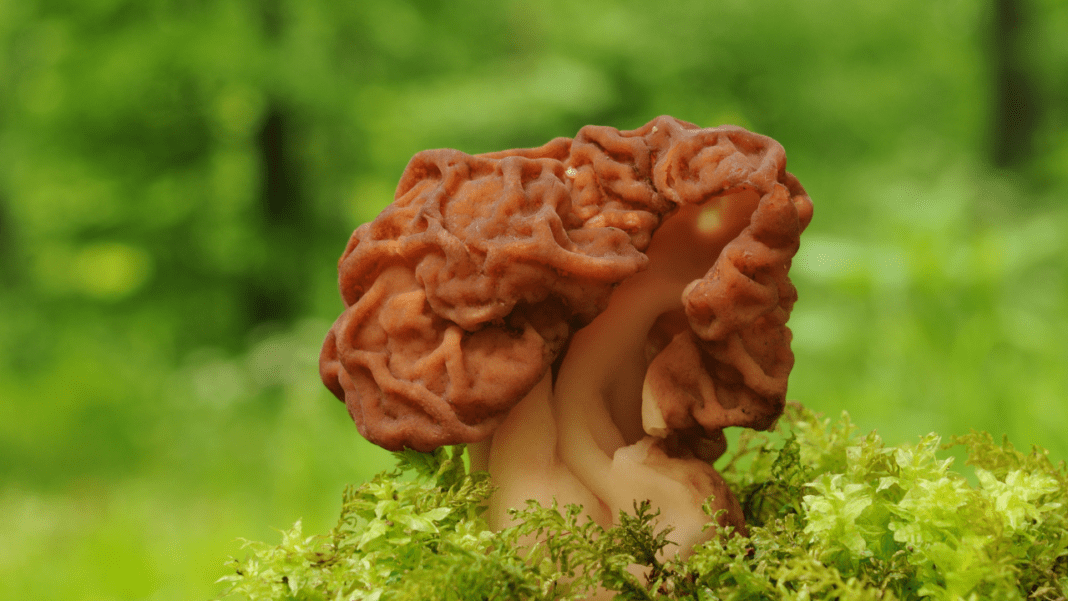Know in one minute about false morel
|
What is false morel?
False morels are a group of mushroom species that are similar to true morels. False morels belong to the Pezizales. There are several species of false morels such as Verpa while some contain gyromitrin which is a carcinogenic organic compound. Gyromitra esculenta , a species of false morel, is an edible species but when eaten fresh it is a deadly mushroom.
How to identify a false morel?
The false morels are generally wrinkled and appear as the cap because of multiple wrinkles. The cap is usually reddish–brown, purplish – brown or dark brown in color. Some false morels are chambered with a longitudinal section, whereas some species such as Verpa have a cottony substance inside their stem. Caps are generally free from the stem. Stems are short and white in color. Found in pine trees, or on woody debris.
Fact about false morel
False morels or Gyromitra are mostly seen between spring and summer, mostly grown in the ground but some are grown in the woods, therefore they are mycorrhizal. They are commonly seen in the disrupted forest floor.
False morels are saprophytic in nature as they are dependent on dead and decaying organic matter for their nutrition.
Several species of false morels are found such as Gyromitra esculenta, Gyromitra caroliniana, and Gyromitra infula.
Some of the false morels contain a toxic substance named gyromitrin. Gyromitrin is a toxic substance that has a carcinogenic effect. It gets easily hydrolyzed to the Monomethyl hydrazine (MMH), which acts on the central nervous system ( CNS) and disturbs the normal functioning of Vitamin B6. The poisoning of gyromitrin causes nausea, diarrhea, stomach cramps, jaundice, and convulsion and sometimes it also leads to death also.
True Morel vs false morel
True morels |
False morels |
| The cap of true morels is uniformly shaped. | The cap of false morels is wavy or wrinkled and folded. |
| There are ridges and pits present on the cap, which gives a honeycomb appearance to the cap. | Because of multiple wrinkled folds, caps look brain-like. |
| True morels are always hollow. | Some species of false morels are cottony inside the stem. |
| Inward bulging is present | Outward bulging is present |
| In true morels cap is generally attached to the stem. | In false morels, caps are mostly free from the stem. |
Q&A
1. Are false morels edible?
There are some species of false morels such as verpa, that are edible. Can consume cooked and raw both. But the excess consumption of false morels may cause several gastrointestinal disorders, loss of muscular coordination, and death in certain cases.
2. Can you eat false morels?
Ans. Yes, there are some species of false morels, which you can eat. An example of edible false morels is verpa.
3. Are false morels poisonous?
Ans. Yes, there are some species of false morels such as Gyromitra esculenta, which contains the toxic compound gyromitrin. Gyromitrin is hydrolyzed into Monomethyl hydrazine (MMH). This compound is responsible for mushroom poisoning and causes gastrointestinal disorders, and liver and kidney damage, sometimes it may also result in death. The symptoms of mushroom poisoning include vomiting, diarrhea, dizziness, and loss of energy.
4. What does a false morel look like?
Ans. False morels look wrinkled or brain like appearance due to the multiple wrinkle folds on the cap. caps are reddish brown or dark brown in color and attached to the stem base only or free from the stem. Sometimes it looks like the cotton bunch inside the stem.
Note: This article on false morel is for informational purposes only. We do not recommend eating this mushroom without conducting thorough research and consulting a qualified expert.
Written By: Neetu Ladiya
